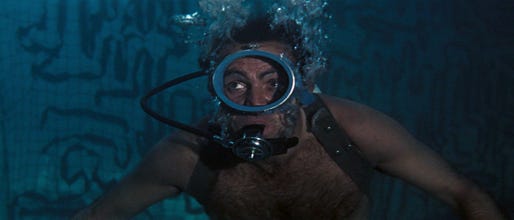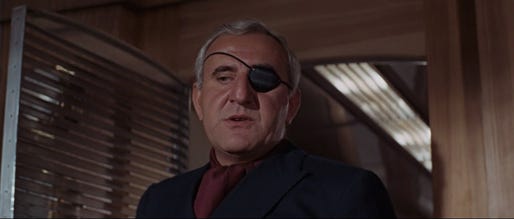You Only Live Twenty-Thrice: "Thunderball"
“You Only Live Twenty-Thrice” is a look back at the James Bond films.
Each Friday until the release of the 23rd official Bond film, “Skyfall,” we will revisit its 22 official predecessors from start to finish, with a bonus post for the unofficial films in which James Bond also appears.
Today, the aspect ratio at which a film is shot speaks as much to its ambition as its budget. Generally speaking, the “flat” 1.85:1 (or 1.66:1) ratio is the domain of small-scale comedies and dramas, while the “scope” 2.35:1 (or 2.39/2.40:1) ratio suggests you’re about to see something big, booming and, more often than not, a blockbuster.
“Thunderball” was the first James Bond film to use the “black-bar” scope format, but man, does it fall flat. And one moment sums up its many, many shortcomings.
Bond (Sean Connery) and hopelessly naïve Dominique “Domino” Derval (Claudine Auger) are dancing at a party with a live band. A man stands with a trumpet to his lips, and there’s a whole role of saxophones ready to pounce. And as Bond and Domino shimmy, you wonder: Where is that string music coming from, exactly?
It’s an uproarious continuity error — a trend that would continue through the next two Bond films. Light fluctuates in the same scene (also a hindrance in “On Her Majesty’s Secret Service”), and shots are clearly recycled (as they would be in “You Only Live Twice”). However, no other Bond film highlights a dog peeing in the street.
This dance scene is also part of a sad farewell to Bond from director Terence Young, who introduced him to world cinema in “Dr. No” and delivered the series’ finest entry with “From Russia with Love.”
And it’s also a sad metaphor spelling out how, for the first time, a Bond film just danced through the motions without the right kind of music. Even Tom Jones’ titular theme is more vibrato than vibe.
The 1965 production of “Thunderball” was fraught with legal wrangling, delayed release and, most tellingly, the disenchantment of its star. After four films as Bond in as many years, the paparazzi attention and publicity duties began to push on Connery’s nerves — allegedly straining his marriage to actress Diane Cilento and causing him to grant only one promotional interview, to Playboy.
Even amid beautiful, blue Bahamian waters and a bevy of beauties, Connery looks like he’d rather be anywhere else. His displeasure and disenchantment creeps into the Bond character, too.
Double-Oh seems to have little fun chasing down two rogue nukes stolen by Emilio Largo (Adolfo Celi) on behalf of SPECTRE and held for ransom deep in the waters of Nassau. Celi boasts a Spencer Tracy thickness, an unexplained and unthreatening eyepatch and a placidly paced plan for panic. Plus, Largo’s brutish henchman is so devoted to vice that he never smokes, drinks or screws. Wow. That’s … fascinating?
“Thunderball” was no picnic for Albert “Cubby” Broccoli and Harry Saltzman, either. Synonymous with the Bond series, these producers relinquished their credit to Irish filmmaker Kevin McClory — as part of a byzantine web of legal action that began when “Thunderball” was to be Bond’s big-screen debut and persisted for years.
McClory was a former collaborator of novelist Ian Fleming, creator of the James Bond character. Joined by writer Jack Whittingham in 1959, the trio conceived a script that went unproduced (due in part to McClory’s diminishing stock in Hollywood). In 1961, Fleming then used said script’s plot for the “Thunderball” novel, at which point McClory and Whittingham sued him.
Out of court, Fleming settled for rights to the novel (with a qualifying description that credited McClory and Whittingham), and McClory received film rights. Broccoli and Saltzman brokered their deal fearing McClory would produce a rival Bond film. In 1983, he’d do just that — pitting the unofficial, Connery-starring “Thunderball” remake “Never Say Never Again” against the official “Octopussy.”
That’s a lot of handwringing and hullabaloo over what is essentially the “Moonraker” of Connery’s Bond run — a misstep defined by heyday technology of something producers thought would look cool. And aside from an opening jetpack sequence, “Thunderball” lacks “Moonraker’s” uproarious kitsch element.
“Thunderball’s” main gimmick is underwater exploration and battle, which easily sucks up a quarter of its 130 minutes with dives, submersibles and the sort. How epic and unprecedented it must have seemed in pre-production, choreographing full-scale below-surface battles. How boring and blocky it looks, with big scuba-suited brutes slamming into each other for 10 minutes on end and lots of bodies flailing in suffocation.
The only underwater scene of note involves Bond trying to stay alive in Largo’s shark-infested pool … and that’s only because the sharks were really inches from Connery’s face. That look of concern isn’t acting.
Amazingly, when adjusted for inflation, “Thunderball” remains the most profitable Bond film — earning $141.2 million worldwide, or about a billion dollars in today’s market. Narratively, the only remarkable thing about “Thunderball” is that it finally kicked off a short run of Bond girls who measure up to more than 36-26-36.
It’s not masseuse Patricia Fearing (Molly Peters), whom Bond lands after she saves him from an “osteopathic traction” machine cranked up to catastrophic speeds. Certainly even at the time, this scene had to seem supremely ridiculous. Right?
Fearing, however, was the first Bond girl seen removing her clothes onscreen. And although Peters’ butt is blocked by frosted glass, hers is the first true nudity in a Bond film — one far more overt about sex than its predecessors.
It’s also not Paula Caplan (Martine Beswick, who played a catfighting gypsy in “Russia”), Bond’s dishy partner who’s basically there to drive him around, look pretty and then die. And it’s sure not Auger’s Domino, a one-dimensional drip who belongs to big bad Largo until Bond swoops in.
No, the first Bond girl worth a damn as a character is the ruthless Fiona Volpe (Luciana Paluzzi), a SPECTRE assassin who’s lethal with weapons and vehicles. She presides over nearly all of the few electrifying moments in “Thunderball.” And sexually, she flusters Bond enough to make him sweat.
In a terrifically tense scene, Volpe pushes a Mustang to 100, with Bond as a passenger and dimmed headlights on a winding road. And she’s the first to call him out on smug (if amusing) sexist gestures like this:
After that scene, Volpe is the one who takes charge of the seduction. Only afterward, once he’s learned of her leanings, Bond weakly blurts that his tumble in the sack with her was purely for King and country. Her reply, which brings to mind Pussy Galore’s ridiculous post-rogering change of heart in "Goldfinger":
“James Bond, who only has to make love to a woman and she starts to hear heavenly choirs singing. She repents and then immediately returns to the side of right and virtue.”
Burn.
Volpe also orchestrates the setpiece during which Bond is shot in the ankle as he evades her and a group of assassins. It’s the most debilitating injury we’ve seen Bond suffer yet, and Volpe comes as close as she can to killing him before she’s dropped by her own assassin’s bullet.
Eventually, Bond rallies for a climactic battle with Largo aboard the Disco Volante, Largo’s awesomely named yacht, and it yields a relatively involving knock-down, drag-out brawl. (Note, however, the random champagne-toting lackey at 59 seconds). Then there’s this lamely abrupt, dialogue-free finale in which Auger makes a painful attempt at silent curiosity.
Largo might have stowed away twice as many atomic bombs as Goldfinger, but his plot packs about one-eighth of the payload. Sadly, “Thunderball” leaves us with a sense it was made by people more interested in going to the bank than to the brink.
Next week: “You Only Live Twice”
BULLET POINTS Johnny Cash recorded a theme song that was rejected. God bless the Internet.
Shooting in Panavision — and, thus, a new aspect ratio — required a reshoot of the iconic opening-credits target sequence. Pinhole camera technology allowed title designer Maurice Binder to actually film through a gun barrel. Plus, for the first time ever, Sean Connery appears in this sequence; previously, it had been his stunt double, Bob Simmons.
The explosion of Emilio Largo’s Disco Volante looks so spectacular because filmmakers used experimental rocket fuel to detonate the boat. It’s said that, not knowing its power, the crew doused the boat with the fuel, and resultant shockwaves shattered windows along Bay Street in Nassau … 30 miles away.
Julie Christie, Raquel Welch and Faye Dunaway were all candidates to play Domino before producer Kevin McClory saw Claudine Auger while holidaying in Nassau and recommended that she audition. Too bad.
Adolfo Celi and Anthony Dawson (who plays the unseen Blofeld) sent up their “Thunderball” roles in 1967’s “OK Connery” (aka “Operation Double 007”). The Italian spoof starred Connery’s younger brother, Neil, as the younger brother of England’s best spy. Past Bond cast members joining them were Daniela Bianchi (“From Russia with Love”) and, rather surprisingly, Bernard Lee and Lois Maxwell, playing slight variations on M and Moneypenny (who allegedly toted a gun in this).




